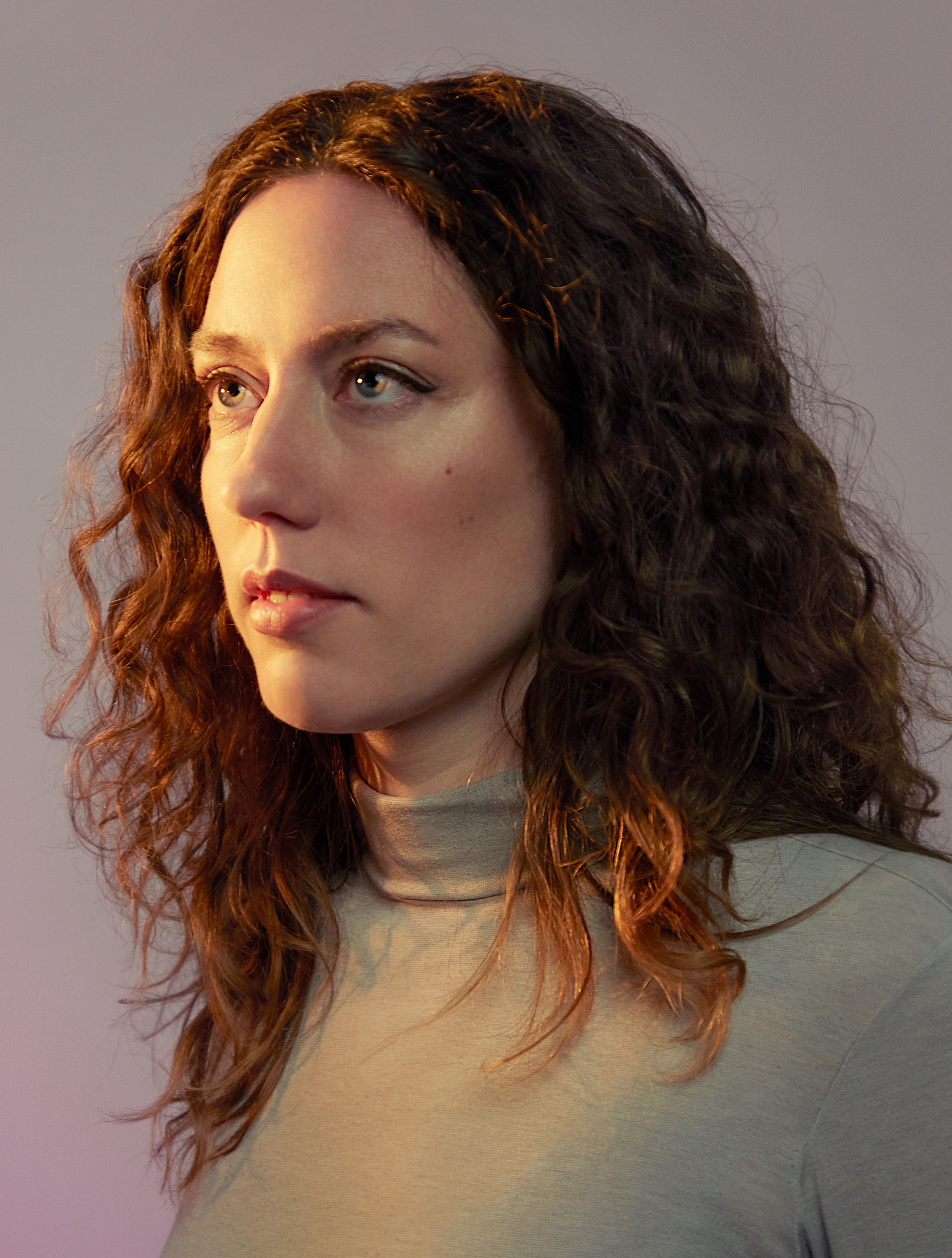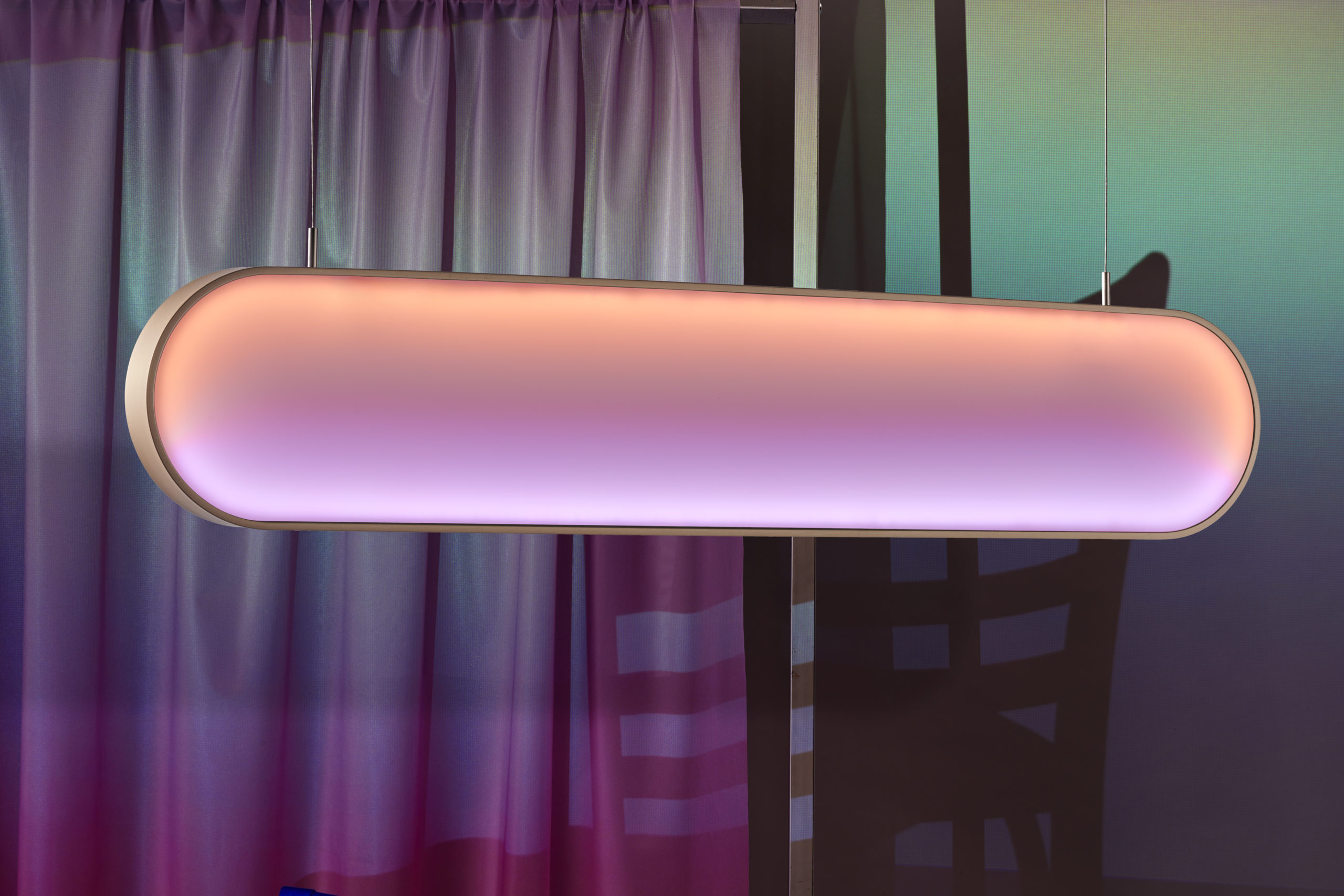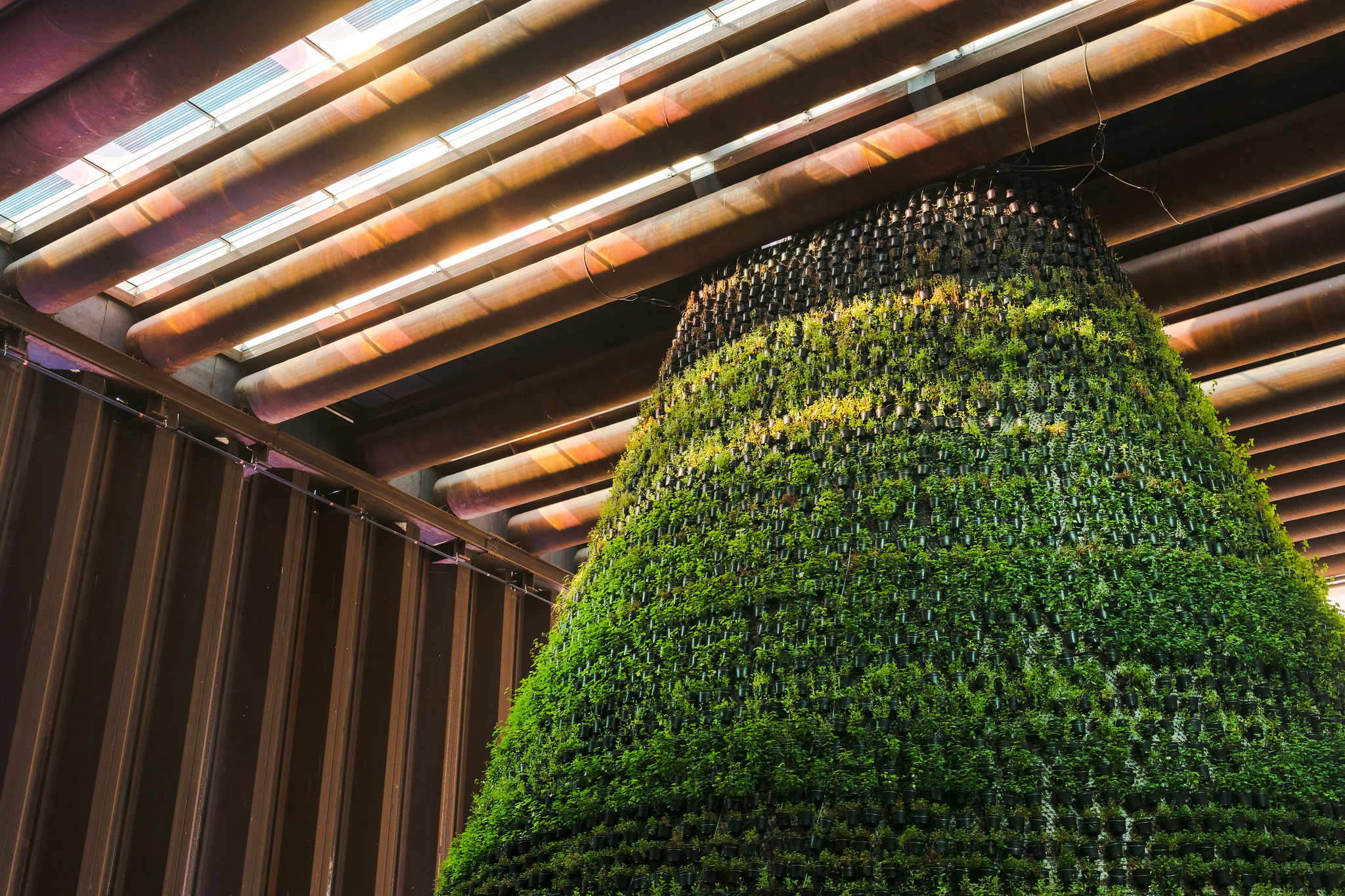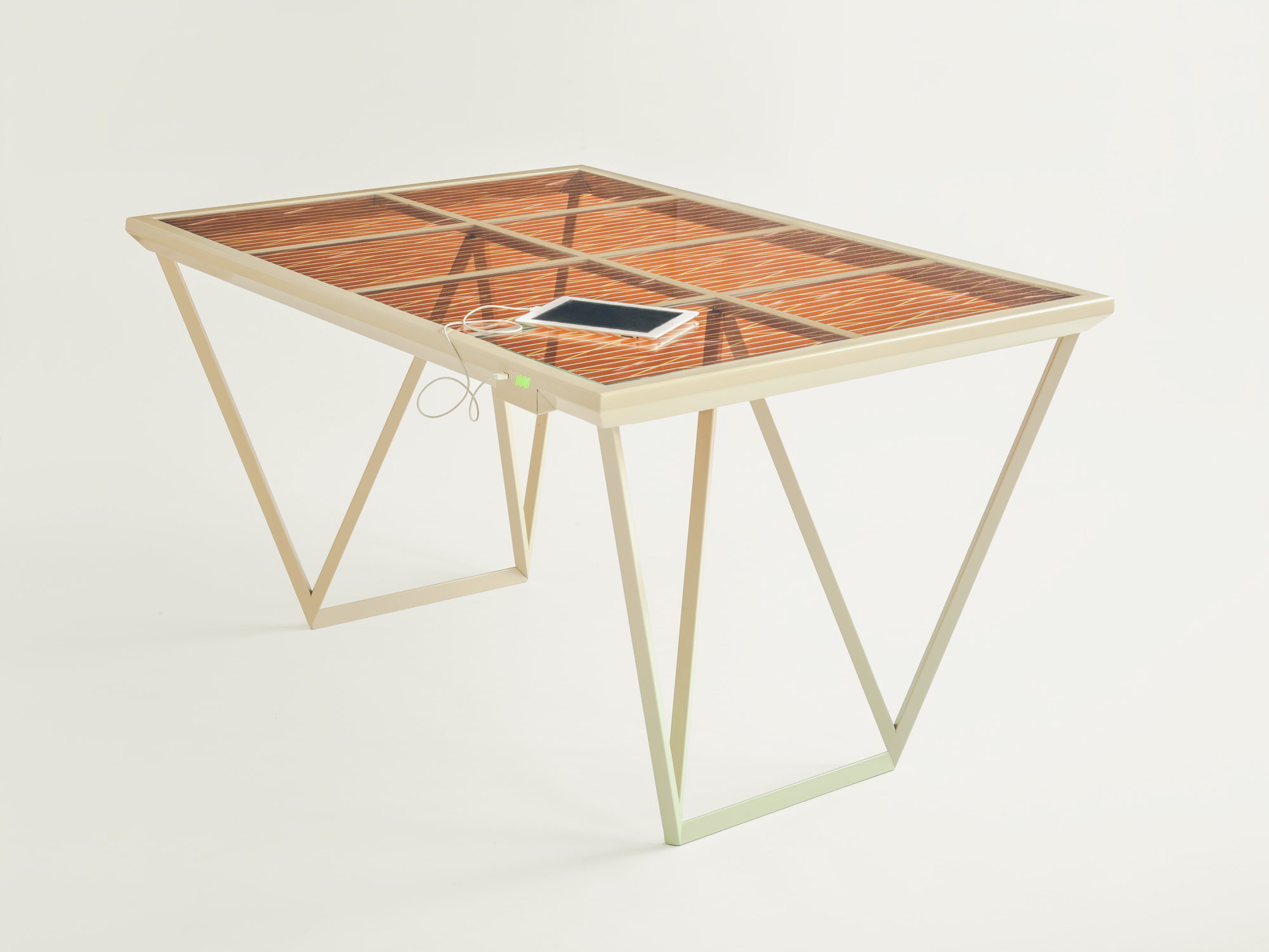KAIROS 24- OBJECT 24
Object: a bottle of water that you can re-fill
How can we democratize solar energy? Wouldn’t it be great if we look at solar anew, and no longer see them as big rigid installations? There are plenty of ways to change the perspective and democratize solar energy. It can be small and integrated, and can be temporarily rolled out at deserted spaces for a period of time. It’s something that can be charged and shared, and you can carry it around like a bottle of water.
 photo: Sander Plug
photo: Sander Plug


ON Marjan van Aubel
Marjan van Aubel is an award-winning innovative solar designer that brings solar energy into daily life. Designing for a positive future through combining the fields of sustainability, design and technology.
The studio is creating lasting change through solar design, integrating solar power seamlessly into our environments such as in buildings and objects. With the goal to make solar power more accessible for everyone. Most notable works are Sunne, Current Table, Power Plant and the roof of the Netherlands Pavilion at the World Expo 2020 in Dubai.
Marjan has collaborated with global brands such as Cos, Timberland, Swarovski with the aim of accelerating global energy transition to solar. Graduating from the Royal College of Art (Design Products MA) in 2012 and the Rietveld Academy DesignLAB (BA) in 2009.
KAIROS 24 – A Talk with Marjan van Aubel – 17 Participants
Zusammenfassung
Marjan van Aubel // Kairos 24
Key themes:
The primary focus of the seminar and Marjan’s “kairos moment” came when she was writing her dissertation on the future of colour at the Royal College of Art, London. Her research led her to solar cells that could generate energy using the “properties of colour”. Her logic followed that if glass could be a generator of power perhaps everyday objects could be designed so that they could use this technology to harness energy. What if the abundance of the sun could be harnessed through the use and existence of household objects? If this could be done the way we perceive and operate energy generation could be completely reshaped. And thus so could the world. Putting the users in direct relation and control of the energy they produce as well as consume. “A solar democracy”. It is this idea that drives Marjan’s work.
Marjan’s asked us to bring a water bottle to the seminar. This was to draw a connection between how we see water bottles today and how she envisions we could see energy in the future. A future where we would fill everyday objects with energy the same way we fill a water bottle. This reinforcing the concept of this “solar democracy” where the user of objects, i.e. the people, are in control of the energy they use and generate. This having obvious sustainability and social implications.
This new function of energy generation could operate in tandem with an objects main function but could also be completely separate/secondary to their primary use. This way nearly all objects could be transformed into implements of “solar democracy”
Early career:
When she first started work with solar generation she got in contact with Michael Grätzel, famous for the pioneering of cost effective alternatives to silicon based solar cells in the 1990’s, at the EPFL laboratory where she was able to familiarise herself with the technology. This proved to be fruitful and inspirational for her work as she had only the idea of this solar integration and no real concept of how to implement it. She said that as a designer you bring a certain naiveté that means your ideas exist outside of the realm of the logistics and technicalities that dominate those who work in the lab. Meaning that her ideas may have been impractical but they provided alternative perspectives to how to utilise the technology and thus how to develop it. An example of this naiveté would be that she wanted to design cylindrical solar cells but due to the available technology only flat cells could be produced.
Eventually after working with the dye sensitised solar cells for a time her and the rest of the solar industry realised that the technology was not suitable for the future and that they must move onto more practical technologies in order to progress. This brought up an important point that she made of being able to let go of projects that are not working and move onto to greener pastures. In her case out of this letting go she moved onto to OPV solar cells that proved to be much more applicable to her work.
Projects:
The first project briefly mentioned was “The Energy Collection” project that proposed her vision for solar democracy in its infant stage. The project was a conceptual shelf that acts as a hub/battery from which everyday objects such as glasses, plates, jugs etc. It would use dye sensitised solar cells built into their exterior to harvest and use the energy from the sun and use it as power for household objects. This project acted almost as a manifesto of her intentions and as stepping stone from which she could go begin to bring this concept to life with practical projects.
The next projects discussed were her “Current Tables”. Tables whose top surface is made of dye sensitised solar cells that act as a generator of energy for appliances that can be plugged in via a side USB port. Her thinking being that the kitchen table is a universally utilised object that would act as a suitable hub for energy generation and use. Marjan had the intention of starting a company to produce the tables but unfortunately as mentioned before the technology was realised to be inefficient and not scalable so they had to be cancelled. This project was however enormously informative for her however as it showed what producing a solar generation product would be like as well as helping her focus how she wanted to utilise the technology in the future. Namely that she realised that a table as an object would be problematic because of inherent elements. In her eyes a table would be much too stationary and cumbersome an object for individual use so she wanted something more portable to allow for a much more individualised control of one’s energy generation and use.
Her next project discussed that tackled what she diagnosed as the problem with her “current Tables” was her “cyanometer” with Swarovski, an Austrian jewellery company. She utilised their glass technology to increase the efficiency of energy generation –The glass utilised refracts light at specific angles so that it is more intensely focused onto the solar cells-. The portable solar crystal harvests the light during the day and when plugged into the docking station “gives the sensation of taking the sky indoors”. The nature of the project and working with Swarovski meant the project focused more upon utilising existing technology to make product as opposed to using the project as a means of development and experimentation which for her was informative but didn’t satisfy her drive to push the technology. She also highlighted the how the design process changed: she would simply hand over a design and the company would develop and produce the object independently. This felt quite alien to her as she was so used being hands on at every stage. In her words this way of working was almost “boring”, for her. Though she still thought it useful, as it helped her gain some perspective on how to work with a company and also give her the knowledge simply that she prefers to remain hands on throughout development.
One interesting point arose while discussing her “Power Plant” project. The project involved researched into using solar generation as a means of generating food in self-sustaining modular greenhouses. This project arose out of her returning to Holland where she noticed Holland’s large number of greenhouses. Their use harnesses the sun’s energy to produce food that helps sustain local populations. This led her to formulate the idea for the “Power Plant”. -As a side note returning to Holland from London gave her a fresh perspective on her country that she wouldn’t have noticed if she had not spent time elsewhere. A point she made was that spending time away from something or somewhere can lend a new and valuable perspective-. She then spent a year researching into this topic working with both scientist/researchers and agricultural experts to try and develop a solution. While initially enthused she ultimately ended up stepping away from the project as she felt that the agricultural sector was too profit driven. However her research and pushing of the idea helped kick start further research into this area so while she may not have been able to come to a solution she was able to spark interest and development into a new area of research. Which is valuable itself. As part of this research she had to deal with people from completely different fields whose approach to production is completely different and she emphasised how important a skill it is to be able to mediate different groups of people in order to collaborate on a solution. Related to this she also mentioned how important it is to not only imagine your ideas but create them or at least give them form so that those who cannot envision your product can begin to do so.
For her contribution to the Dutch Pavilion in Dubai at the world Expo 2020 a few interesting points were raised in terms of her approach to designing for such a brief. Marjan was chosen for the pavilion because the theme of the Dutch “Biotope” pavilion related to a self sustaining, self sufficient structure where solar energy was used to power its functions. All parts of the design were designed in a way that they could be deconstructed after the expo had concluded. For example the steel structural material was borrowed from a bridge construction company and after the expo the material was given back to be used by them. The solar panels that Marjan was responsible for also used technology that was light weight compared to her other projects so that it would be more eco friendly to have shipped to Dubai. The solar panels were also designed in a way without adhesive so that they could be separated from each other and be shipped where needed more efficiently. This approach to design gave her a new perspective on how to apply her technology in the future.
She is currently working on her “sunne” project which is a self contained light source that gets it’s power from solar energy generated during the day. She feels as though more embodies her ideal for solar democracy as its energy generation translates directly into a consistently useful functionality. This in comparison to her table projects that she felt were too impractical for individual use and her projects with Swarovski and the Dutch design pavilion that were too dependent on the whims of other people/companies. With this project she feels as though she is in full control of it’s direction. Something that she briefly mentioned was that the prototype of the object cost a lot of money and she emphasised the economy of scale and how it is important to scale your products production so that manufacturing is cheaper(If this is the intention for the project obviously). A closing point to this project was that you have to realise the multi faceted nature of product development including packaging, shipping advertising etc. Which in her words “I’m happy that I didn’t know everything as if I had known everything I wouldn’t have started”? Though she is obviously still happy and satisfied with it’s outcome. She also briefly said that she was using kickstarter in order to gather funding for the project. She thinks that kick-starter is a really useful tool in jump starting projects but she also recommended seeking guidance and help in order to use it to its fullest potential as she was aware of it’s multifaceted complexities when she first envisioned using it to fund the project.
Marjan’s Future:
Marjan was asked what her intentions are for her future work and projects and whether she will remain working exclusively with solar technology. For her the she feels a drive to do something sustainable with her work: “I’m just creating more objects into a world that has already enough objects”. And she sees working with solar technology as the best way she can help contribute to the energy transition. In terms of integrating new technology she is very open made an offhand comment about working with nano technology but she feels that working with solar has helped her focus her approach to design and helped her really find what she is passionate about making so she intends to continue forward with it.
In her opinion the most exciting new technologies include the ability to print on solar panels. While this does decrease the efficiency marginally Marjan believes that the ability for solar panels to be utilised by artists will encourage more people to enter the space and perhaps further bring solar energy and technology into the public consciousness. An example of a company using this technology is UN studio. Or also the ability to bend and curve solar panels which is being used in the “lightyear one” car. A car powered by solar cells.
Advice:
A question posed to Marjan was how she was confident enough to start a line of communication with companies in order to work with them. In her opinion there is no way around biting the bullet and simply having the confidence to step out and communicate with people. All the clients she has worked with the exception of Swarovski and the Dutch design pavilion she was the one who got in contact first. So it goes to show you need to take the initiative to be able to work with companies. Especially when first starting off. Though she stressed that you have to understand that as a designer you will most likely be misunderstood. You just mustn’t be dissuaded. You have to learn to be able to empathise with people’s perspective so that you can adapt your approach to communication and collaboration.
One point she made regarding working with companies was that companies operate differently depending on what sector they work in. For example social sector companies have a much more fluid approach to production with design, ideation and manufacture all informing each other. Usually with an intended goal in mind. Whereas technical sector companies operate more based on monetary and profit driven incentives where progress and development is fuelled by investment. This is just something that she advised us to keep in mind when working with companies as many may not be as idealistically driven as we would like. Tying into her point of how you must be adaptable and understanding of industry shortcomings in order to succeed.
Luke Deighton
